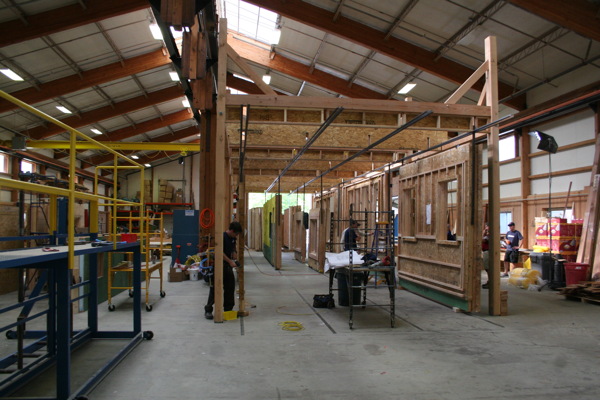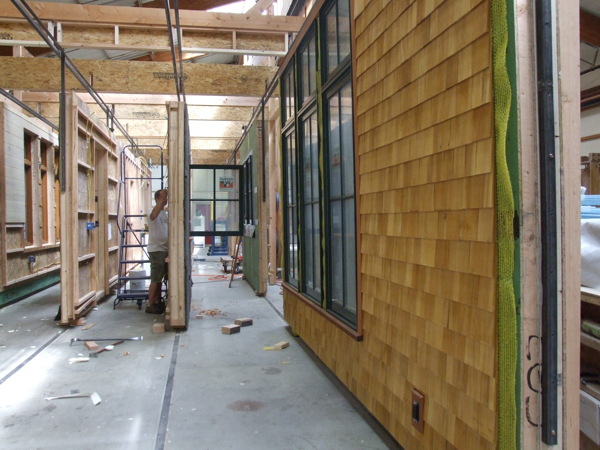PreFab is Dead - When can we expect MMC/OSM?
For the past week I've been writing about what is wrong with PreFab in the US, and I've been writing about what is right about OSM in Sweden. The inevitable question is when will that come to the US? Is there anybody building like that now? The answer is while there is nobody working precisely as the Swedes do here, there is a builder who works with a very similar process, and even more importantly is an active student of Swedish and German building techniques. That builder is Bensonwood out of Walpole New Hampshire and we've just begun to offer our house designs built by them. But before the big announcement, let's look at what they are doing.

There are a number of US builders that have imported the various machines that are like the ones used in Sweden and in Germany, and they have used them for fabricating houses in panels - panelization as its called. But these builders do not attempt to finish their walls on both sides. Few even attempt to finish them on one side. Hence much of the great advantage of the technique is lost as a great deal of the work is still sent out to the field. There have even been attempts to import houses from Sweden, shipping them in their flat panel form to be assembled here in the States. A small quantity of houses were built and sold, but the designs of the Swedish houses admittedly did not make a clean fit to American expectations. For the most part the American housing industry has ignored Sweden's great achievement. A government funded report on the Swedish housing industry from the 1980s called "In From the Cold" documented the progress and results of the change to housing in Sweden. They presented this as a model for the US industry to follow, and then it largely fell on deaf ears. The researchers that conducted the study and wrote the report threw up their arms and moved on to other research topics. The few that have taken up some of these lessons have never carried them very far into the building process. They've done open panels, little more.
Bensonwood's journey into this was somewhat different. Coming from the American timber framing craft, Tedd Benson was quick to adopt computer driven milling equipment that he saw being used in Germany. This led him into the other types of automated fabrication techniques that were being used there, as well as leading him to be being present for the birth of the Passive House movement in Germany. Benson has been steadily taking this technology and the lessons of how they were building back to his shop in New Hampshire and evolving the way he builds homes here in the States. He's faced the same stumbling blocks that we've reviewed in examining the Swedish factory. Our building products here don't help you to panelize your walls, never mind make a high performance home. So along the way Bensonwood has been diligently adapting American products, importing european products where practical, and inventing what was missing, all in the pursuit of an intelligent manufacturing process. There is that word again! Intelligent! They have been connecting the dots where American component suppliers fail to, and building more and more value into their product. This is their form of MMC and OSM.

So where are they? Right now Bensonwood has several standardized wall and roof construction models that they can use to build a wide range of typical Amercian homes. Basically, if a home can be stud framed, then the Bensonwood system can be used to build that house. The system is offered in different degrees of insulation value to suit your climate, but it is worth noting that these can be used to build a home to a Passive House level of performance. Bensonwood calls their system Open-Built® and it supports the core philosophy of how they approach building homes. Number one the system is capable of very high energy performance. Number two it is configured for separation of utilities and structure, which allows the changes that happen over the life of a home to go on without interfering with the structure or spoiling the air tight envelope of the house. This supports Bensonwood's belief that a home should be built to last for generations.
The reasoning of Swedish factory builders is not precisely the same, but the prototypical wall construction in Sweden is very similar. Consistently they create an interior side chase space inside of the homes vapor barrier that allows wires, switch boxes, and plumbing to go where needed without puncturing the airtight envelope of the house. Bensonwood's Open-Built is the only thing approaching this offered in the US. There simply is no "PreFab" house that takes this deep approach to building science and performance offered in the US.

Bensonwood is also building with largely finished wall panels as the Swedes are, although they continue to offer partially finished packages for US builders that choose to finish the work themselves. However Bensonwood currently works their panels in a vertical orientation using a unique racking station that they've created themselves. Whether they transition to flat work like the Swedes remains to be seen. The process is ever evolving and there is always more to learn. The materials and finishes offered by Bensonwood reflect their New England roots, and as such the selections are extremely high quality and consistent with the high quality of their product.
We are excited to begin offering our house designs through Bensonwood, built to their high standards. We believe this opens up an entire new opportunity to our customers who are very interested in energy performance and the concerns of a sustainable and green home owner. Up till now the only option for people who liked our designs were our house plans. Out of necessity these are very generalized when it comes to performance. They are designed to use the most common construction materials, to make them easy to build, and build-able over the greatest range of locations. Bensonwood's offering opens up a new market for those interested in our designs, but seeking the best performance they can get. The universality of our designs make them readily adaptable to Bensonwood's building systems. We are really looking forward to seeing them build your LamiDesign modern house.




Good luck with your new venture with Bensonwood and thanks for sharing your views on why prefab construction may be flawed. Two questions:
ReplyDelete1. is there a realistic % cost savings you are predicting compared to the traditional prefab construction methods in the U.S.?
2. what new and distinctive consumer buzz word are you planning to use in replacement of "prefab"?
The reasoning of Swedish factory builders is not precisely the same, but the prototypical wall construction in Sweden is very similar. Consistently they create an interior side chase space inside of the homes vapor barrier that allows wires, switch boxes, and plumbing to go where needed without puncturing the airtight envelope of the house. Bensonwood's OpenBuilt is the only thing approaching this offered in the US. There simply is no "PreFab" house.....
ReplyDeleteif what you say is true then it just sounds like pre-fab only deeper...pre-fab is alive and evolved. sheesh
ThinIL - Thanks for your well wishes. Cost savings are hard to distill, since in both the case of Sweden and Bensonwood the effort includes building a higher performance wall. In Sweden their houses ended up costing roughly the same, maybe slightly more - but the transition there was propped up by government support for the move to more energy efficiency. In Bensonwood's case cost is more than conventional status quo building certainly, but I would say with some confidence less than site building the same thing.
ReplyDeleteI don't think we have a consumer buzz-word, unless you would like to suggest something. MMC and OSM are in common usage in Sweden, UK, and other places where the translation aligns. We'll probably just stick with that until something else emerges.
r s thompson - you are a skeptic, and that is fine. Whether you believe or not the added value will still be there if you decide to get a Bensonwood house.
ReplyDeleteYou are totally right Greg that we need a new term to signal this new way of thinking and new way of working. This is a total system that the Swedes have evolved.
ReplyDeleteThen toyota replaced the assembly line, they just called it the "Toyota Production System".
Now it is called "Lean" and everyone associates it with Toyota. I think it will be up to Bensonwood, and the other early adopters like yourself to coin a term, "Offsite" building and Lean Construction or "Modern Offsite" could work.
I think it will require commercial success, and an insistence by the people who have that success on calling their success by the terms they decide that will move the discussion.
As you can see from Thompson above, "prefab" just seems so persistent it is hard to change and it isn't totally obvious why it should, as he says, "its only prefab deeper".
I'm sure there were people who looked at the toyota factories and said, "it just an assembly line"! or "its an assembly line, only deeper."
I guess that is true, but because toyota thought about it differently they called by a different name. hell it was their factory they called it by their words.
In fact, today we use all these japanese terms ... right though the mfg. world. "Gemba", "Muda", "Kaisen" ... ask anyone who works in a multi national corporation what these terms mean ... they know, and they signal a way of thinking which is distinctive and has a whole process of problem solving with it. Everyone had to do it there way, because their way was the better way.
You are doing us all a favor by pointing out that "Prefab" is Dead, and Modern Offsite using lean principles ... or MMC is here.
Funny isn't it how you have all this talk about prefab, for decades, and no one notices how this all fits in with modern trends in industry.
Till they do. Good work!
Thompson is like the guy who said Toyota was just doing an assembly line, only deeper.
ReplyDeletegreg, i don't know if you had seen this yet...
ReplyDeletethe z-home in washington state is using OSM'd panels. they're assembled by a japanese panel maker ichijo USA, although built in philippines and shipped to US.
I recognize the project but I've not dug deep into what they are doing. The panels that they are receiving/installing appear to only be framed and insulated. There is no interior or exterior finish, nor does the electrical work appear to be installed. Ichijo may very well do all that in their market, but clearly not with what they are shipping to WA. I think its almost tragic that they could not have those panels made here. The shipping may be something that turns out carbon neutral, but we could certainly use the jobs.
ReplyDelete